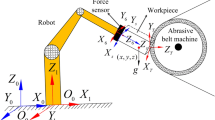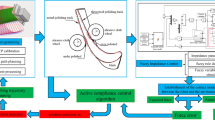Abstract
The hybrid force/position control base on fuzzy proportional-integral-derivative (PID) is proposed to improve the quality of robotic automatic grinding aviation blades. First, the perception for the contact force/torque is discussed. A multi-source parameters gravity compensation matrix is established to identify the parameters through matrix reorganization. The contact force/torque is perceived according to the gravity compensation result. Then, the hybrid force/position control base on fuzzy PID is designed to realize active force control. Nevertheless, the sharp edge phenomenon occurs although the force control algorithm, which seriously affects the grinding quality of blades. Finally, the fusion control of force and torque is proposed to weaken the sharp edge phenomenon. The experiment proves that the introduction of torque control avoids effectively the sharp edge phenomenon. Meanwhile, comparing the proposed control algorithm with the traditional PID control, the results show that the proposed hybrid force/position control based on fuzzy PID can ensure the stability of the contact force and improve the quality of the aviation blades.



















Similar content being viewed by others
References
Cho S, Ryu Y, Lee S (2002) Curved surface finishing with flexible abrasive tool. Int J Mach Tool Manu 42(2):229–236
Zhang L, Tam HY, Yuan C-M, Chen Y-P, Zhou Z-D (2002) An investigation of material removal in polishing with fixed abrasives. Proc IMechE B: J Eng Manuf 216:103–112
Tsai M, Huang JF, Kao WL (2009) Robotic polishing of precision molds with uniform material removal control. Int J Mach Tool Manu 49(11):885–895
Huang H, Gong ZM, Chen X, Zhou L (2003) SMART robotic system for 3D profile turbine vane airfoil repair. Int J Adv Manuf Technol 21(4):275–283
Huang H, Gong ZM, Chen X, Zhou L (2002) Robotic grinding and polishing for turbine-vane overhaul. J Mater Process Technol 127(2):140–145
Jung S, Hsia TC, Bonitz RG (2004) Force tracking impedance control of robot manipulators under unknown environment. IEEE Transact Control Syst Technol 12(3):474–483
Lopes AM, De Almeida FA (2008) A force-impedance controlled industrial robot using an active robotic auxiliary device. Robot Comput Integr Manuf 24(3):299–309
Du H, Sun Y, Feng D, Xu J (2015) Automatic robotic polishing on titanium alloy parts with compliant force/position control. Proc Inst Mech Eng B J Eng Manuf 229(7):1180–1192
Sun Y, Giblin DJ, Kazerounian K (2009) Accurate robotic belt grinding of workpieces with complex geometries using relative calibration techniques. Robot Comput Integr Manuf 25(1):204–210
Chen F, Zhao H, Li D, Chen L, Tan C, Ding H (2019) Robotic grinding of a blisk with two degrees of freedom contact force control. Int J Adv Manuf Technol 101:461–474
Nagata F, Hase T, Haga Z, Omoto M, Watanabe K (2007) CAD/CAM-based position/force controller for a mold polishing robot. Mechatronics 17(4):207–216
Zhan J, Yu S (2011) A new aspheric surfaces polishing by parallel orthogonality movement/force servomechanism. J Manuf Sci Eng-Transact ASME, 133(3). https://doi.org/10.1115/1.4004140
Zhan J, Yu S (2011) Study on error compensation of machining force in aspheric surfaces polishing by profile-adaptive hybrid movement–force control. Int J Adv Manuf Technol 54(9):879–885
Tian F, Li Z, Lv C, Liu G (2016) Polishing pressure investigations of robot automatic polishing on curved surfaces. Int J Adv Manuf Technol 87:639–646
Thomas G, Chien M, Tamar A, Ojea JA, Abbeel P (2018) Learning robotic assembly from CAD. International Conference on Robotics and Automation, 3524-3531
Liu Z, Nakamura T (2006) Combination of robot control and assembly planning for a precision manipulator. Int J Adv Manuf Technol 31(7):797–804
Jasim IF, Plapper P (2014) Contact-state monitoring of force-guided robotic assembly tasks using expectation maximization-based Gaussian mixtures models. Int J Adv Manuf Technol 73(5):623–633
Chen S, Xia R, Zhao J, Zhang H, Hu M (2017) Analysis and reduction of phase errors caused by nonuniform surface reflectivity in a phase-shifting measurement system. Opt Eng 56(3):033102–033102
Funding
The study was financially supported by the National Natural Science Foundation of China (grant no. 51775542) and National Key Research and Development Program of China (grant no. 2016YFB1100502).
Author information
Authors and Affiliations
Corresponding author
Additional information
Publisher’s note
Springer Nature remains neutral with regard to jurisdictional claims in published maps and institutional affiliations.
Rights and permissions
About this article
Cite this article
Zhang, H., Li, L., Zhao, J. et al. Design and implementation of hybrid force/position control for robot automation grinding aviation blade based on fuzzy PID. Int J Adv Manuf Technol 107, 1741–1754 (2020). https://doi.org/10.1007/s00170-020-05061-y
Received:
Accepted:
Published:
Issue Date:
DOI: https://doi.org/10.1007/s00170-020-05061-y




